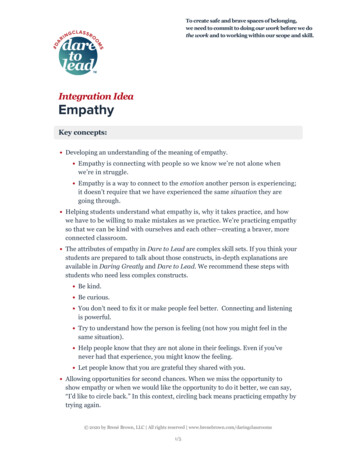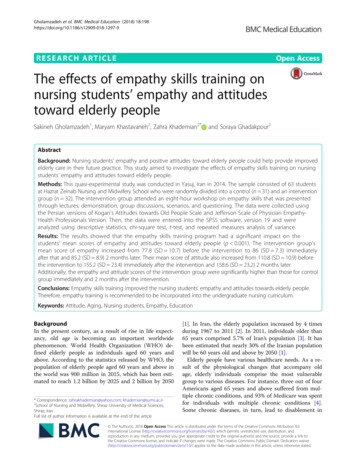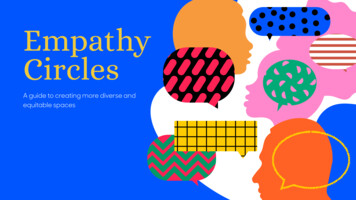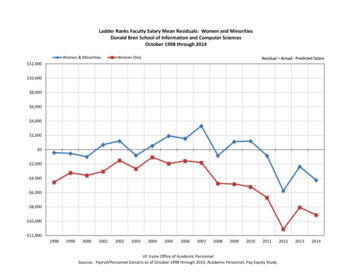
Transcription
To create safe and brave spaces of belonging,we need to commit to doing our work before we dothe work and to working within our scope and skill.Integration IdeaEmpathyKey concepts: Developing an understanding of the meaning of empathy. Empathy is connecting with people so we know we’re not alone whenwe’re in struggle. Empathy is a way to connect to the emotion another person is experiencing;it doesn’t require that we have experienced the same situation they aregoing through. Helping students understand what empathy is, why it takes practice, and howwe have to be willing to make mistakes as we practice. We’re practicing empathyso that we can be kind with ourselves and each other—creating a braver, moreconnected classroom. The attributes of empathy in Dare to Lead are complex skill sets. If you think yourstudents are prepared to talk about those constructs, in-depth explanations areavailable in Daring Greatly and Dare to Lead. We recommend these steps withstudents who need less complex constructs. Be kind. Be curious. You don’t need to fix it or make people feel better. Connecting and listeningis powerful. Try to understand how the person is feeling (not how you might feel in thesame situation). Help people know that they are not alone in their feelings. Even if you’venever had that experience, you might know the feeling. Let people know that you are grateful they shared with you. Allowing opportunities for second chances. When we miss the opportunity toshow empathy or when we would like the opportunity to do it better, we can say,“I’d like to circle back.” In this context, circling back means practicing empathy bytrying again. 2020 by Brené Brown, LLC All rights reserved www.brenebrown.com/daringclassrooms1/5
Be mindful: People often confuse sympathy with empathy. Sympathy is I feel bad FOR you.Empathy is I feel WITH you. Sympathy can make us feel more alone. Empathyhelps us feel connected. Empathy is a practice that grows over time—we often use the example ofshooting free throws in basketball. You have to miss a lot of shots before you startconsistently making them. Empathy is not something that should be measured orevaluated, only taught, encouraged, and modeled.Examples: A friend doesn’t understand what we are doing in math class rightnow. I am really good at math, so I haven’t experienced feeling upset about math,BUT I know what it’s like to not understand an assignment because I often feel thatway about science. We are connecting to the emotion of feeling lost and frustratedin class, not connecting with the specific experience of not understanding thecurrent topic in math class.Classroom Discussion Ideas: Brené’s RSA short on empathy can be a great starting place for discussion. Thevideo can be found at brenebrown.com/dcvideos. When it comes to empathy, we all have different needs and even our ownneeds may differ depending on the situation. There is no right or wrong way todemonstrate or receive empathy. One way to illustrate this is to read the followingstatements and responses aloud, and have students raise their hands when theyhear responses that they can relate to. Be sure to explain that there are no right orwrong answers. When I’m having a hard time or my feelings are hurt and I sharewhat I’m feeling with someone, I like that person to: look right at me look away a little so it doesn’t feel so hard give me a hug give me some space say something so I’m not just standing there just listen and stay quiet 2020 by Brené Brown, LLC All rights reserved www.brenebrown.com/daringclassrooms2/5
When someone is having a hard time or their feelings are hurt,and they share what they’re feeling with me: I worry that I might not say the right thing I want to say something that will make them feel better I get nervous I want to fix it A community empathy commitment can serve as a great reminder to practiceempathy in the classroom (and in general). On a chart paper or bulletin board write, “I agree to practice empathy, messup, circle back, clean it up, and try again.” Have every student in the class sign the commitment. Empathy Misses: Empathy is a complex skill, and there are some common waysthat we all sometimes get it wrong. We call these “empathy misses.” Developingan understanding of the common empathy misses can help us learn how to showaccurate empathy. This concept might be most appropriate for secondary schoolstudents – teachers will know best if their students are ready for these. Oneeffective exercise is to have students work in teams to role-play scenarios foreach type of empathic miss and then practice responding to the same situationwith empathy. This exercise helps students differentiate what empathy is andisn’t. It is extremely powerful to see this in action because we’ve all been onboth sides of the misses. A shorter version of this exercise is to read each of theempathy misses aloud and have students silently raise hands indicating the onesthey can relate to. (Either they have done this themselves when trying to beempathic or they have been on the receiving end.) Empathy Miss #1: Sympathy vs. Empathy The friend who responds with sympathy (“I feel so sorry for you”) ratherthan empathy (“I get it, I feel with you, and I’ve been there”). Empathy Miss #2: The Gasp and Awe The friend who hears your story and feels shame on your behalf. Theymay gasp and tell you how horrified you should be (“OMG, I can’tbelieve you did that.”) When this happens we feel the need to make theother person feel better rather than asking for what we need, which isempathy. Empathy Miss #3: The Mighty Fall 2020 by Brené Brown, LLC All rights reserved www.brenebrown.com/daringclassrooms3/5
The friend who sees who as perfect. They are so let down by yourimperfections and disappointed in you (“I just never expected that fromyou. I didn’t think you would ever be someone who didn’t do well. Whathappened?”) Empathy Miss #4: The Block and Tackle The friend who is so uncomfortable with vulnerability that they criticizeyou (“What happened?! What were you thinking?”). Empathy Miss #5: The Boots and Shovel The friend who is all about making it better and, out of their owndiscomfort, refuses to acknowledge that you can actually make terriblechoices (“You’re exaggerating. It wasn’t that bad. You rock. You’reperfect. Everyone loves you”). They are trying so hard to make you feelbetter that they’re unable to connect with your emotions. Empathy Miss #6: If You Think That’s Bad The friend who confuses “connection” with the opportunity to one-up you.(“That’s nothing. Listen to what happened to me one time!”) Empathy Miss #7: I Can Fix That! The friend who immediately jumps to problem-solving rather thanjust being with you in your experience. Most of us struggle with thisone, especially if friends often come to us for help solving problems.One helpful empathic reply is to acknowledge the feelings and ask,“What does support look like?” This gives the person in struggle theopportunity to say, “Just listening helps” or “Can you help me figure thisout?” Discussion Questions for either version of the empathy miss exercise: When you were on the receiving end of an empathic miss, how did it feel? When you have missed or messed up empathy with a friend, how did itfeel? Knowing what you know now, what would you do differently? 2020 by Brené Brown, LLC All rights reserved www.brenebrown.com/daringclassrooms4/5
In addition to reading Dare to Lead, you can learn more here:Books:I Thought It Was Just MeDaring GreatlyVideos (brenebrown.com/dcvideos):RSA Short: EmpathyLearning Lab Videos (brenebrown.com/dc-learning-labs):What happens when empathy gets hard? 2020 by Brené Brown, LLC All rights reserved www.brenebrown.com/daringclassrooms5/5
Empathy Integration Idea To create safe and brave spaces of belonging, we need to commit to doing our work before we do the work and to working within our scope and skill. Key concepts: Developing an understanding of the meaning of empathy. Empathy is connecting with people so we know we're not alone when we're in struggle.










